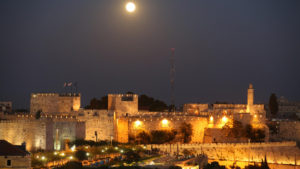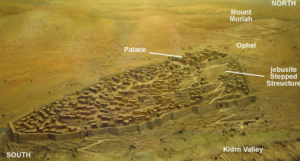Jerusalem – the Messiah Connection

Jerusalem, an ancient, world-famous city with no natural wealth or strategic value – no harbor, no navigable waterway, no major trade routes, militarily isolated with valleys on all four sides, not even a natural water source within its walls – an improbable city in the desert.[1]
Happenings of great religious significance began at the place about 1000 years before the future city would ever come to be called Jerusalem. The city’s entire existence is based almost solely on its religious heritage.
A 2000-year history preceded the era of Jesus of Nazareth. Salem/Jebus/Jerusalem produced a legacy of kings, births, deaths, prophecies, angels, sacrifices, blessings, wars, exile and restoration.
Going back in history, one day God instructed Abram to move from Haran (in present day Iran) to an unnamed location in Canaan. Abram and his family resettled in a strange land near Salem whose King was Melchizedek and also a priest of God.[2]
During these years, God blessed Abram, changed his name to Abraham and promised he would become the father of a great nation.[3] His miraculously-born son, Isaac, would pass on his father Abraham’s blessing.
One of Isaac’s twin sons was named Jacob, his name was later changed by God to Israel. Based on a lie perpetrated by his other brothers to their father, Joseph was very much alive, but had been sold into slavery.[4]
Many years later Israel, along with his 11 other sons and their families, Israel moved to Egypt because of a famine. Unbeknownst to the entire family, Joseph had become the second most powerful man in Egypt next only to Pharaoh, revealed his true identity and protected the family of Jacob.[5]
Over the next 400 years, the 12 tribes of the Children of Israel became slaves of Egypt. Meanwhile back in Canaan during the absence of the clan of Israel, the Jebusites occupied Salem coming to be known as Jebus.[6]
Fleeing Egypt, the Hebrews miraculously escaped through the Red Sea arriving at Mt. Sinai. Five big promises in the Law given to Moses atop Mt. Sinai tied to the place – God just didn’t say exactly where the place would be.[7]
All promises required a city – a new homeland for the city; the throne for a king; a permanent place for His Name to dwell; a permanent place to observe the Feasts; and the place of the judgment seat of Israel.
As a visual sign of His promise, God sent an angel in the form of a pillar of cloud by day; by night, a pillar of fire. Both were designed to remind the Hebrew nation of God’s presence and to lead them to the place that He had chosen.
EX 23::20, 23 “See, I am sending an angel ahead of you to guard you along the way and to bring you to the place I have prepared.… “For My angel will go before you and bring you in to the land of the Amorites, the Hittites, the Perizzites, the Canaanites, the Hivites and the Jebusites…”(NASB)
EX 33:1-2 “Then the LORD spoke to Moses, “Depart, go up from here, you and the people whom you have brought up from the land of Egypt, to the land of which I swore to Abraham, Isaac, and Jacob, saying, ‘To your descendants I will give it.’” I will send an angel before you and I will drive out the Canaanite, the Amorite, the Hittite, the Perizzite, the Hivite and the Jebusite.” (NASB)
God twice called out the occupants of Salem – the Jebusites.[8] Problem was that the fortified city was occupied by the Jebusites and every attempt by the fledgling Hebrew nation to defeat the Jebusites had been unsuccessful.[9]
David had become famous as a giant slayer and skilled warrior while serving in King Saul’s army.[10] As King himself, David gathered the Hebrews from the surrounding areas to form a large army, went to war with Jebus and took the city.

Salem – Jebus – Zion was now called the City of David coming to be known as the City of Jerusalem. Jerusalem became the capital of Israel and the throne of King David fulfilling two of God’s promises.
Mount Moriah was now within Jerusalem. King Solomon built the Temple on Mt. Moriah becoming the place where the Passover was celebrated at its appointed time.[11]
An interwoven trail of blessings, testing of faith, much drama, prophecies made and fulfilled over the course of a millennia, all climaxed with the glory days of Jerusalem under King David. Splendor would be short lived – the end of David’s reign marked the beginning of the nation’s deterioration.
Spiraling out of control, the downhill slide led to the point all would be eventually lost. Jerusalem with its Temple was destroyed by Nebuchadnezzar and select inhabitants were exiled to Babylon.
A millennium after its height of glory during David’s reign, a comeback for Jerusalem came under King Herod. During that era, Jesus of Nazareth appeared on the scene, born in the same town as David, Bethlehem, and in the royal lineage of King David.
Consistent with multiple Messiah prophecies, the life of Jesus culminated when he was placed on trial in Jerusalem and crucified, consistent with multiple Messiah prophecies. Were these just multiple coincidences or was Jesus the promised Messiah?
Updated January, 2025.
This work is licensed under a Creative Commons Attribution-NonCommercial-NoDerivatives 4.0 International License.
REFERENCES:
[1] Gersch, Lili Kalish. MyJewishLearning. “Whose Jerusalem?” photo. n.d. <https://www.myjewishlearning.com/article/whose-jerusalem> “Jerusalem .” New World Encyclopedia. “Jerusalem Archaeological Sites: Biblical Water Systems.” Jewish Virtual Library. 2014.
[2] Genesis 11-15. “Historical Timeline.” The Biblical Zionist. 2009. <http://www.biblicalzionist.com/timeline.htm> Uittenbogaard, Arie. “Salem meaning | Salem etymology.” <http://www.abarim-publications.com/Meaning/Salem.html#.U5SQqCjyTih> Josephus. Wars of the Jews. Book VI, Chapter X.
[3] Genesis 17.
[4] Genesis 32, 35.
[5] Genesis 43; I Chronicles 2:1-2.
[6] I Chronicles 11; Judges 1, 19; Joshua 15; Psalms 76.
[7] Exodus 23, 33; Deuteronomy 12, 17.
[8] Deuteronomy 3:12-22. Ryrie Study Bible. Ed. Ryrie Charles C. “Laws relating to conquests” ref. Ex. 23:20-33.
[9] II Samuel 5:6; I Chronicles 11. “Zion.” Encyclopædia Britannica. 2024. <https://www.britannica.com/place/Zion-hill-Jerusalem>
[10] I Chronicles 11:1-3.
[11] I Chronicles 17:8-13. Josephus, Antiquity of the Jews, Book VII, Chapter III.1-2. “The Temple.” The Victor’s Place. image. Feb. 2. ? <https://images.search.yahoo.com/yhs/search;_ylt=AwrCwOUslAdjzRoASQ0PxQt.;_ylu=Y29sbwNiZjEEcG9zAzEEdnRpZAMEc2VjA3BpdnM-?p=The+Temple%2C+Jerusalem&type=yhs-adk_sbnt_appfocus1_sm_ff¶m1=20210118¶m2=00000000-0000-0000-0000-000000000000¶m3=searchmanager_%7EUS%7Eappfocus1%7E¶m4=%7Efirefox%7E%7E&hsimp=yhs-adk_sbnt&hspart=adk&grd=1&ei=UTF-8&fr=yhs-adk-adk_sbnt#id=96&iurl=https%3A%2F%2Fvhoagland.files.wordpress.com%2F2021%2F02%2Fdsc00129.jpg&action=click>
